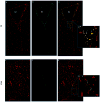BTBR T+tf/J mice: autism-relevant behaviors and reduced fractone-associated heparan sulfate
- PMID: 21741402
- PMCID: PMC3208071
- DOI: 10.1016/j.neubiorev.2011.06.008
BTBR T+tf/J mice: autism-relevant behaviors and reduced fractone-associated heparan sulfate
Erratum in
- Neurosci Biobehav Rev. 2012 Apr;36(4):1265
Abstract
BTBR T+tf/J (BTBR) mice have emerged as strong candidates to serve as models of a range of autism-relevant behaviors, showing deficiencies in social behaviors; reduced or unusual ultrasonic vocalizations in conspecific situations; and enhanced, repetitive self-grooming. Recent studies have described their behaviors in a seminatural visible burrow system (VBS); a Social Proximity Test in which avoidance of a conspecific is impossible; and in an object approach and investigation test evaluating attention to specific objects and potential stereotypies in the order of approaching/investigating objects. VBS results confirmed strong BTBR avoidance of conspecifics and in the Social Proximity Test, BTBR showed dramatic differences in several close-in behaviors, including specific avoidance of a nose-to-nose contact that may potentially be related to gaze-avoidance. Diazepam normalized social avoidance by BTBRs in a Three-Chamber Test, and some additional behaviors - but not nose to nose avoidance - in the Social Proximity Test. BTBR also showed higher levels of preference for particular objects, and higher levels of sequences investigating 3- or 4-objects in the same order. Heparan sulfate (HS) associated with fractal structures in the subventricular zone of the lateral ventricles was severely reduced in BTBR. HS may modulate the functions of a range of growth and guidance factors during development, and HS abnormalities are associated with relevant brain (callosal agenesis) and behavioral (reductions in sociality) changes; suggesting the value of examination of the dynamics of the HS system in the context of autism.
Copyright © 2011 Elsevier Ltd. All rights reserved.
Figures





References
-
- American Psychiatric Association. Diagnostic and statistical manual of mental disorders. 4. American Psychiatric Association; Washington, DC: 1994. DSM-IV.
-
- American Psychiatric Association. Diagnostic and statistical manual of mental disorders. 4. American Psychiatric Association; Washington, DC: 2000. DSM-IV-TR.
MeSH terms
Substances
Grants and funding
LinkOut - more resources
Full Text Sources
Miscellaneous

